Hi friends, as a user from Bangladesh, I appreciate the efficiency and simplicity when it comes to registering with online platforms like https://baji-bet.net/registration/. One of the benefits of signing up with Baji-Bet is getting access to exclusive welcome bonuses and promotions. As a new user, I was pleasantly surprised to receive a generous welcome bonus upon completion of my registration, which gave me some extra funds to start my betting and gaming experience. In addition, their team regularly offers special promotions and incentives for loyal customers, rewarding players for their continued support and making the betting experience even more exciting and rewarding. I can highly recommend it to everyone.
Crossing the Atmos Rubicon With The Pineapple Thief’s Visionary Mix Maestro, Bruce Soord

Bruce Soord, guitarist, vocalist, and founder of the British post-prog collective The Pineapple Thief, caught the surround-mixing bug well over a decade ago, and he’s yet to shake it—and that’s quite good news for those of us who admire his learned approach to the 360-degree soundfield. In fact, Soord has since gone all-in on mixing whatever he can in Atmos—and, given the aural fruits of his multichannel output to date, he’s more than giving the king of surround Steven Wilson a run for his multichannel-mixing money.
Some of Soord’s recent, top-shelf all-channel handiwork (each of them available on Blu-ray) includes the jaw-dropping Atmos mix he did for the prog-leaning boundary-pushers Big Big Train and their March 2024 rebirth record The Likes of Us (InsideOut Music) and the respective openness he took in the way he approached the Atmos expansion of Jethro Tull’s 23rd studio album, April 2023’s RökFlöte (InsideOut Music)—not to mention the clever Atmos soundscapes he deployed for The Pineapple Thief’s own 15th studio effort released in February 2024 just ahead of the band’s current international tour, It Leads to This (Kscope).

But don’t just take my word for it. “Bruce’s name was suggested to me by the record company, and I went to his studio to hear the end results of his Dolby Atmos mix,” confirms Ian Anderson, Jethro Tull’s chief songwriter, vocalist, and flautist nonpareil. “I found that he took a rational approach towards where to create a little bit more poignancy in terms of the instrumental positioning.”
Concurs Soord, “I knew what Ian wanted to hear—especially with the flute elements— because the first time he came down to my studio, I played him a test Atmos mix I had done of the previous Tull album [January 2022’s The Zealot Gene]. Ian stood in the sweet spot, listened to that mix, and he was just hooked. That’s how I knew what I was going to do with RökFlöte.”
Ever the perfectionist, Anderson adds, “I did actually ask Bruce to be a bit more radical with a couple of the songs to make them a bit more adventurous in terms of the Atmos mix—and he delivered.” (A true minstrel in the Atmos gallery, as it were. . .)

Now on a clear Atmos roll, Soord’s not done just yet. “That’s where my head’s at right now,” he affirms. “I’ve been going through the Pineapple Thief back catalog, and I already did the first era—which is, I think, nearly eight hours of Atmos mixing. Yeah, it was crazy going back through all those albums! (laughs) And there’s lots of mixing work to do when I get back from the tour, as I’m going to do the next era—and that’s going to be a lot of Atmos mixing too. That will all be coming out in probably a year’s time.” In the meantime, we will eagerly (if only semi-patiently) await Soord’s Atmos versions of The Pineapple Thief’s career-long truth.
On our Zoom call across the Pond during a tour stop in Paris, Soord, 51, and I discussed how he first got into surround mixing, what mistakes he made along the way, and why he strives for achieving a “natural feel” in his Atmos mixes. Those precious words you can never hear / Keeps calling, calling to you. . .

Mike Mettler: I want to get into your “Atmos mentality,” so to speak, as you’ve been doing surround mixes since just around the beginning of time. (both laugh) First, I actually want to go back with you a bit to find out when you wanted to start doing them. Did the idea come to you as something like, “Hey, I can be a 360-degree artist”?
Bruce Soord: In 2012, I did a mix of an acoustic tour by a Swedish metal band called Katatonia. They had done this really stripped-back acoustic tour, and they asked me to mix it. Then the label [Kscope] said, “Oh, can you do a 5.1 mix?” And I thought to myself (furrows brow), “Uhh—no!” (slight pause) But then I basically said (chuckles), “Yes!” (chuckles)—and I upgraded my studio to 5.1.
[MM adds: The Katatonia album Soord is referring to here is March 2015’s Sanctitude, on Kscope. Both the CD/DVD and BD editions feature that 5.1 mix.]

Soord: Obviously, there was a big learning curve with 5.1, but I got the Katatonia mix out, and I learned a lot of things by doing that one. I realized what an amazing world it was—the 5.1 world. That was when, every time—every time—I did a mix for anyone, I always asked, “Do you want to do a 5.1? ’Cause it’s really easy. I’ve already done the stereo, and moving it to 5.1 is a quick thing—and it’s worth it. Even if all you can do is have FLACs that people can download, it’s just great.” So, yeah, ever since 2012, I’ve been doing it—and there’s such an amazing community out there.
Mettler: We do love listening to as much surround and Atmos as we can; that’s true. How long did it take you to get comfortable with mixing things in surround sound?
Soord: Like I said, it was a big, steep learning curve. I found that one of the biggest things to figure out was how to completely get the stereo paradigm out of your head. In the early days, I was quite conservative with what I put in the rear speakers. I learned very quickly that that wasn’t what people liked—people in the community, I mean. (chuckles) And then, I gradually sort of realized that, actually, it is about putting your head in the middle of the song. So, yeah, it did take a while to figure that out.
Mettler: Right, because you certainly didn’t want to come across as being “gimmicky” at all with where you placed certain elements in those mixes. What you’re saying is, you were able to figure out the question of, “What can I put here that makes more sense in 5.1?” (Soord nods) Was there some kind of what I’ll call a “lightning bolt” 5.1 mix—as in, the first one you did that you thought, “Okay, this is the one that is my benchmark for how I do things in surround”?
Soord: It was probably when I did my own stuff. I remember when I did my first Bruce Soord solo record [2015’s Bruce Soord]—which was digital only, actually—I kind of figured things out.

[MM adds: While there are indeed CD and LP versions of Bruce Soord that were released on Kscope in 2015-16, the 24-bit/48kHz 5.1 FLAC files were initially only available digitally via Soord’s site that same year. In late 2021, the 5.1 FLAC files were made available via the Immersive Audio Album site, which you can check out, preview, and/or order here. You can also delve into the mind-boggling Atmos MKV+MP4 version Soord did for the aforementioned 2023 solo release Luminescence here.]
Soord: But I did make some mistakes—I’ll be happy to admit that. I remember I did an Opeth surround sound mix which I was really, really happy with, but the drummer [Martin Axenrot] had four toms, and I decided to put the fills all about the mix. You were talking about “gimmicks”—well, that was gimmicky, but it didn’t work.
[MM notes: Soord is referring to the 2015 24-bit/96kHz 5.1 mix he did for Opeth’s November 2002 album Deliverance, which was part of the band’s 2015-released 2CD/2DVD box set on Music For Nations called Deliverance & Damnation, which was paired/paralleled in the package with the 24/96 5.1 mix Steven Wilson did for Opeth’s April 2003 effort, Damnation.]
Soord: It was then that I realized the drum set needs to stay a drum set. I figured this out over the years, where I don’t have to have it dead-set at dead-front. I bring it forward, ever so slightly—especially the hi-hats—and in the middle. I feel like, when you’re in the 360 and things are really discreet, especially with the drums when they’re right at the front, you lose the effect. I want it to feel almost like you’ve sat on the drum stool.

Mettler: Yeah, yeah—and that’s a great way of putting it, because that’s exactly what it feels like. Especially on the new Pineapple Thief album It Leads to This, I can really visualize the physicality of where you guys are in the mix, even if you weren’t always in the same place while you were recording it. I can visualize how Gavin [drummer Gavin Harrison] is seated, quite literally, and how he’s playing across and around his kit. The way you’ve got him there in the Atmos presentation makes it feel like what I call “naturally atmospheric,” because that’s just what it is in the way it immerses you.
Soord: Yeah. It’s critical, isn’t it, to get that—to get that natural feel, so you don’t actually get distracted by any of it. And, like you say, you’re immersed in it without thinking, “Oh, wow, what’s going on? Wow, look at that!” It should be almost like a dreamlike experience.
Mettler: That’s another great description of the new Pineapple Thief album. To me, your Atmos mix acts like a building mechanism, in terms of how each track starts in a certain place, and then (lifts hands outward and upward) we’re rising up to the height channels at just the right moments. And then, once you get us there, you pull us back down—and then the next track rolls around and you do it again, albeit somewhat differently. I’m especially struck how, in the opener, “Put It Right,” we get that scratchy, edgy guitar tone like a minute or two into it, and then it kind of pulls back and you get it over here (points left) and then you move it over there (points right). I’m curious—what did you do for that? How did you create that effect with your guitar?
Soord: Oh! Well, with the guitars, I tend to use delays. I always like to separate the delays, and have them bouncing around. And, also, the ambience—I quite like to, not completely separate it, but make it sort of wash. That’s something I’ve developed over the years, and obviously, with the Atmos mixes, it’s just—you know, it’s funny. I’ve been talking about 5.1 and how amazing that is—but when you’ve gotten used to doing Atmos like I’m doing now and then you downmix to 5.1, you’re like, “Oh my goodness!” (laughs heartily)

Mettler: Yeah, t’s hard to go back. Isn’t it? It’s really hard to go back. On the track “Now It’s Yours,” at around the 28-minute mark on the Blu-ray where your solo comes in, it’s a big payoff in Atmos. You built us to that point where you just give us the full effect of the volume dynamics you’re playing with there, where everything comes up bigger. You took 28 minutes to get us to that moment, but I think that’s alright because if you had done that in the first 5 or 10 minutes of the album, I don’t think the story’s impact would have made sense to me there. Do you know what I mean? Does that make sense to you, as the artist?
Soord: Yeah—and I think, especially with this new Pineapple Thief album, I’m glad you got that, because it is really an important journey. The sequencing of the tracks was so—we just spent ages trying to figure it out. We’re still romantic about the concept of the album, and playing something from beginning to end. (smiles)
Mettler: Oh, yeah, I still think that’s quite important to do—to listen to an album fully in the order it’s presented to us. By the time we get to your other payoff solo in “Every Trace of Us,” which is around 34 minutes into it and near the end of the album, you give us another key Atmos moment there. Again, we’ve earned it as the listener—and you, as the artist, must feel like, “I’m able to do this here now, because if I gave that to you too early, we wouldn’t have anywhere to go.”
Soord: That’s true. It’s funny that you say, “How do you do it?” I think, because we’ve been doing it for so long, you don’t really give it any too much conscious thought. You know what’s right, and what’s wrong. And with Pineapple Thief, we’ve always wanted to make it so that you don’t blast the listener with the same dynamic.

- Log in or register to post comments

I don’t think the story’s impact would have made sense to me there.
dinosaur game

For businesses and influencers, tracking Story views allows them to assess the effectiveness of promotional campaigns. By correlating increased views with specific promotions or CTAs (Call to Actions), users can measure the impact of their marketing efforts https://storyviewe.com/.




















































